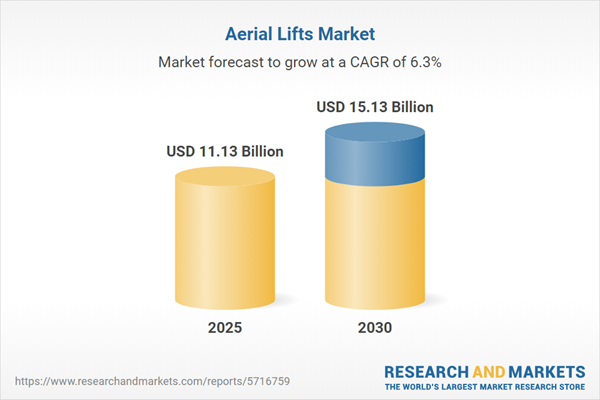The aerial lifts market is experiencing significant growth, driven by their superior mobility and flexibility compared to traditional ladders and platforms. These systems, which include cabins, cars, or open chairs suspended by cables, are widely utilized in construction, maintenance, and industrial applications such as building maintenance, painting, tree trimming, HVAC installation, and inventory management. Key end-users include real estate management firms, construction companies, manufacturers, maintenance service providers, and warehouses. The market's expansion is fueled by rapid urbanization, the rise in high-rise construction, the development of smart cities, and increased investment in construction globally. However, challenges such as limited availability of trained operators, high equipment costs, and safety concerns related to accidents pose restraints to market growth.
Key Growth Drivers
Scissor Lifts as a Market Catalyst
Scissor lifts are a cornerstone of the aerial lifts market due to their safety and reliability for working at height, a critical requirement in construction and maintenance projects. The Occupational Safety and Health Administration (OSHA) has established standards to mitigate hazards associated with scissor lifts, including coverage under its scaffolding regulations, which has bolstered their adoption. In mature markets like North America and Western Europe, where technologically advanced equipment is preferred, safety standards such as those from OSHA and the American National Standards Institute (ANSI) in the U.S., aligned with Canada’s CSA standards, have enhanced productivity while prioritizing worker safety. Japan’s emphasis on stringent safety regulations, combined with a strong presence of original equipment manufacturers (OEMs), further drives demand for scissor lifts across diverse applications, significantly contributing to market growth.Surge in Construction Activities
The global construction boom is a major driver for the aerial lifts market. In India, the construction sector is poised for substantial growth, with projections from Invest India indicating it will become the world’s third-largest construction market by 2025. Key manufacturers are capitalizing on this by offering cost-effective and eco-friendly aerial lift solutions, aligning with the country’s increasing infrastructure investments. Similarly, Brazil’s government initiatives, such as the infrastructure concession program targeting power transmission, railways, ports, roads, and sanitation, alongside programs like Plano Decenal de Expansao de Energia 2026 and Minha Casa Minha Vida, are creating significant opportunities for aerial lift adoption.Regional Insights
North America, particularly the U.S., remains the largest market for scissor lifts, supported by robust safety standards and high adoption of advanced equipment. Japan’s market is propelled by its focus on safety and OEM presence, while India and Brazil are emerging as high-growth regions due to their accelerating construction activities and government-backed infrastructure projects. Germany’s construction sector growth further solidifies its position as a significant market for aerial lifts.Key Benefits of this Report:
- Insightful Analysis: Gain detailed market insights covering major as well as emerging geographical regions, focusing on customer segments, government policies and socio-economic factors, consumer preferences, industry verticals, and other sub-segments.
- Competitive Landscape: Understand the strategic maneuvers employed by key players globally to understand possible market penetration with the correct strategy.
- Market Drivers & Future Trends: Explore the dynamic factors and pivotal market trends and how they will shape future market developments.
- Actionable Recommendations: Utilize the insights to exercise strategic decisions to uncover new business streams and revenues in a dynamic environment.
- Caters to a Wide Audience: Beneficial and cost-effective for startups, research institutions, consultants, SMEs, and large enterprises.
What do businesses use our reports for?
Industry and Market Insights, Opportunity Assessment, Product Demand Forecasting, Market Entry Strategy, Geographical Expansion, Capital Investment Decisions, Regulatory Framework & Implications, New Product Development, Competitive IntelligenceReport Coverage:
- Historical data from 2022 to 2024 & forecast data from 2025 to 2030
- Growth Opportunities, Challenges, Supply Chain Outlook, Regulatory Framework, and Trend Analysis
- Competitive Positioning, Strategies, and Market Share Analysis
- Revenue Growth and Forecast Assessment of segments and regions including countries
- Company Profiling (Strategies, Products, Financial Information, and Key Developments among others).
Aerial Lifts Market Segmentation
By Type
- Boom
- Scissor Lifts
- Telehandlers
By Source
- Electric
- Internal Combustion Engine
By End-User
- Construction
- Mining
- Warehousing & Logistics
- Power & Utilities
- Others
By Geography
- North America
- USA
- Canada
- Mexico
- South America
- Brazil
- Argentina
- Others
- Europe
- Germany
- France
- United Kingdom
- Italy
- Spain
- Others
- Middle East and Africa
- UAE
- South Africa
- Others
- Asia Pacific
- China
- Japan
- South Korea
- India
- Indonesia
- Thailand
- Taiwan
- Others
Table of Contents
Companies Mentioned
- Snorkel lifts
- Terex Corporation
- JLG Industries Inc. (Oshkosh Corporation)
- NIftylift (UK) Limited
- Altec Inc
- MEC
- Manitou Group
- Linamar Corporation
- Tadano Ltd.
- Toyota Material Handling
Table Information
| Report Attribute | Details |
|---|---|
| No. of Pages | 149 |
| Published | June 2025 |
| Forecast Period | 2025 - 2030 |
| Estimated Market Value ( USD | $ 11.13 Billion |
| Forecasted Market Value ( USD | $ 15.13 Billion |
| Compound Annual Growth Rate | 6.3% |
| Regions Covered | Global |
| No. of Companies Mentioned | 10 |









